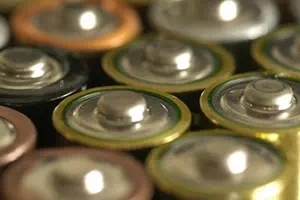 |
||
- Regulated Medical Waste
- Hazardous Materials
- Hazardous Waste
- Pharmaceutical Waste
- Regulations
- Waste Reduction
- Facilities Management
- Assisted Living /
Nursing Homes - Dental Offices
- Search
- Contact
- Home
 Waste Reduction—Batteries Waste Reduction—Batteries
Types of Batteries Alkaline: Common household batteries, AAA, AA, C, D, 9-volt. Can contain mercury, chromium and zinc. Lead-acid: Used in vehicles, wheelchairs, forklifts, and portable generators. Contain lead. Lithium: Used in some cameras. Contains chromium. Mercuric oxide: Also known as ‘button’ batteries. Used in hearing aids, cameras, smoke detectors, tape recorders, electronic computers, voltage regulators, pagers, oxygen monitors, fetal monitors, portable EKG monitors, and until recently, in cardiac pacemakers. Contain mercury. Nickel-cadmium: Rechargeable batteries used in calculators, handheld tools, alarm systems, pages and as back-up power sources in medical monitors and equipment (usually built in by manufacturer). Although these are rechargeable and can be used many times, they eventually need to be disposed of and contain high levels of nickel and cadmium. Silver cadmium: Used in medical electronics and require high-energy density and constant voltage. Contain silver and cadmium. Zinc-air: This button battery has been developed as an alternative to the mercuric oxide battery, though it is not mercury free. It is used in such devices as hearing aids and electronic pagers. Contains zinc and mercury. Risks
Compliance Requirements
Alternatives(Not many alternatives… just need to recycle them.) Battery Recycling
More ResourcesAn Ounce of Prevention: Waste Reduction Strategies for Healthcare Facilities. ASHES of the American Hospital Association. AHA Catalogue No: 057007. 1993. P139-41. Mercury-Containing and Rechargeable Battery Act (PDF): https://www.epa.gov/rcra/mercury-containing-and-rechargeable-battery-management-act-public-law-104-142 |